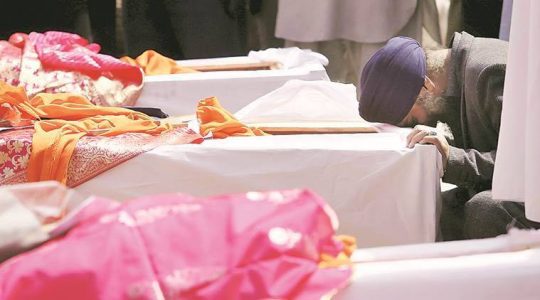
Islamic State-Khorasan branch which attacked the Kabul gurdwara is led by ex Lashkar-e-Taiba man
The leader of the Islamic State-Khorasan (IS-K), which claimed to have carried out the attack on the Kabul gurdwara, migrated to the group from the Lashkar-e-Taiba, the UN designated terrorist organisation linked to the Pakistani security establishment.
The 43-year-old Mawlawi Aslam Farooqi, who took over the leadership of the IS-K last year, is a Pashtun who joined the Lashkar-e-Taiba terrorist group in 2004.
The IS-K is a loose conglomerate of several jihadist tanzeem with differing targets and aims. The group’s relations with the Taliban, and with Pakistan, are critical elements in its still evolving identity.
India condemned the gurdwara massacre as “a cowardly attack” that showed the “diabolical mindsets of the perpetrators and their backers”, a thinly veiled reference to Pakistan.
For months, the Indian security establishment has flagged that the IS-K is now virtually a front of the LeT. Although India has hinted at this in its statement, the missing piece that some security officials are puzzling over is why the LeT would target the Sikh community at a time when, according to these officials, Pakistan has gone out of its way to woo this Indian minority group, especially since mid-2018, through the Kartarpur Corridor initiative.
Farooqi took charge of the IS-KP in April 2019, according to a report submitted to the UN Security Council in July 2019 by a UN committee that monitors Daesh (or Islamic State), al-Qaeda and other terrorist groups.
The report said Farooqi (also spelt Faruqi), who had been previously in charge of IS-K operations in the Khyber region on the Pakistan-Afghanistan border, was promoted to the leadership in place of Mawlawi Zia ul-Haq in April 2019.
“Ul-Haq’s demotion was reportedly due to poor performance in the context of ISIL-K setbacks in Nangarhar [province in Afghanistan] in the second half of 2018. The new leadership nomination was made during a visit by an ISIL core delegation, underscoring the direct relationship between ISIL-K and the ISIL core in Iraq and the Syrian Arab Republic,” said the report by the Analytical Support and Sanctions Monitoring Team of the Daesh and Al Qaeda Sanctions Committee of the UNSC.
In his book The Islamic State in Kohrasan — Afghanistan, Pakistan and the new Central Asian Jihad, Antonio Giustozzi, a well known academic who has written extensively on the IS and Afghanistan, has provided a detailed account of the rise of Farooqi in IS-K. Giustozzi says Farooqi was chosen as the “governor of Khorasan” by the military shura of IS-K on May 22, 2018, a year earlier than what the UN report says.
Two months later, in July 2018, IS-K claimed an attack on a convoy of Sikhs and Hindus in Jalalabad, in which 19 people were killed, 13 of them Sikhs.
Giustozzi writes that Farooqi, an Afridi Pashtun from Pakistan, was based in Afghanistan from 2007-2014, from where he was sent along with a batch of 167 LeT fighters to fight alongside Islamic State Syria. Like several others in that delegation, which included fighters from other groups too such as Lashkar-e-Jhangvi and Tehreek-e-Taliban Pakistan, Farooqi had joined the IS before returning to Pakistan in 2016, as did a 100 other LeT fighters in that group.
Quoting an IS-K source, Giustozzi says the decision to make Farooqi leader “was the result of contacts with the Pakistani ISI”, possibly as a trade-off — “the appointment of a leader linked to the ISI and the cessation of attacks against Pakistani government targets, in return for access to safe havens in Pakistan”.
He also says that for the same reason of his closeness to the ISI, Farooqi’s appointment was a source of tension and opposition from other groups that make up the IS-K.
The IS-K was formed by a coming together of two main groups – one called the Tehreek-e-Khilafat Pakistan that had elements of the TTP and the Lashkar-e-Jhangvi, which saw opportunities in the far wealthier ISIS; and the other, Tehreek-e-Khilafat Khorasan, which saw itself as an anti-Afghan Taliban group. The IS-K also includes several other groups including Chinese and Uzbek jihadists.
From among the Pakistani groups, the LeT was not as readily welcomed by IS-K as the LeJ or the TTP. For the IS-K, Pakistan too, was an enemy, along with America and the “puppet” Afghan government in Kabul. So was the AfghanTaliban, which according to IS-K, was not fighting a pure jihad. The LeT was seen as “a representative of the Pakistan government”, and those who joined from the LeT were treated with suspicion.
Source: India Times





